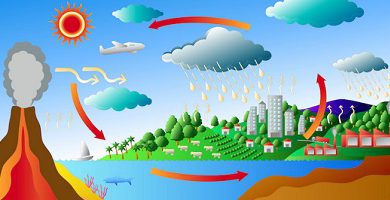What is a chemical formula?
We explain what a chemical formula is, the types that exist, examples and their parts. In addition, chemical symbols and elements.
-
What is a chemical formula?
A chemical formula is a graphic expression of the elements that make up any chemical compound , as well as the numbers and proportions of their respective atoms , and in many cases also the type of chemical bonds that bind them. Each molecule and / or compound known corresponds to a chemical formula, as well as a name from it and according to the rules of chemical nomenclature.
There are different types of chemical formulas, each one focused on a certain type of information, but in general, they all serve to understand the chemical nature of substances and to express what happens during a given chemical reaction , in which some elements or compounds become in others. For that reason, chemical formulas obey a conventional system of representation of elements and molecules , that is, a specialized technical language.
Chemical formulas use the chemical symbols of the elements and formal logical proportions between them, expressed by mathematical symbols.
-
Types of chemical formula

There are different types of chemical formula, useful for providing different information, such as:
- Molecular formula. The basic type of formula expresses the type of atoms present in a covalent compound and the amount of each, in a linear sequence of symbols and numbers (as subscripts). For example, the molecular formula of glucose is C6H12O6 (six carbon atoms, twelve hydrogen and six oxygen).
- Semi-developed formula Similar to the molecular one, it is a type of formula that expresses the atoms that make up the compound, expressing the chemical bonds (lines) and their type (single, double, triple) between each molecule of the compound. This is useful to identify the radical groups that comprise it, as well as the chemical structure of it. For example, the semi-developed glucose formula is: CH2OH-CHOH-CHOH-CHOH-CHOH-CHO.
- Formula developed. The formula developed is the next step in semi-developed complexity, indicating the bond and location of each atom of the compound within their respective molecules, in a Cartesian plane, representing the entire structure of the compound. For example, the developed glucose formula is as follows:H – C = O
|
H – C – O – H
|
H – O – C – H
|
H – C – O – H
|
H – C – O – H
|
H – C – O – H
|
H
- Structural Formula In order to represent the molecules, not only in their structure and organization, but also in their spatial form, an even more complex formula is needed, employing bi-dimensional perspectives.
- Lewis formula Also called Lewis diagrams or Lewis structures, it is a representation similar to the developed formula of a compound, but indicating the respective electrons shared in each chemical bond between atoms, according to the valence of the elements involved. These electrons are represented by points linked to a line where there is a link. They are formulas for technical use and very specific.
- General Formula. It is a generic formula, which expresses the fundamental basic structure of some type of chemical compound, using variables to express the amount of atoms of each type. For example, the general formula of alcohols can be expressed as follows: CnH (2n + 1) OH.
-
Examples of chemical formula
Some examples of the chemical (molecular) formula of known compounds are:
- Oxygen. O2
- Ozone . O3
- Carbon dioxide . CO2
- Carbon monoxide. CO
- Water. H2O
- Ammonia. NH3
- Methane. CH4
- Propane. C 3 H 8
- Sulfuric acid . H2SO4
- Hydrochloric acid. HCl
- Sodium chloride. NaCl
- Sodium bicarbonate. NaHCO3
- Formaldehyde. CH2O
- Benzene. C6H6
- Saccharose. C12H22O11
- Cal. CaO
- Ethyl alcohol. C2H5OH
- Monosodium glutamate. C5H8NNaO4
- Penicillin. C16H18N2O4S
-
Parts of a chemical formula

As we have seen, chemical formulas are composed of chemical symbols (letters) and subscripts (numbers) , which express the type of atoms present in the substance and their quantity. However, in certain fields of chemistry, such as the so-called organic chemistry, the compounds show some structural and functional recurrence, which allows identifying portions of the molecule as radicals (molecular units with free bonds) or functional groups (complete and closed molecular units ).
In this way, certain atomic organizations always have the same proper name , as is the case of the hydroxyl functional group (-OH), typical of alcohols; or of the methyl radical (-CH3).
-
Chemical symbols
The chemical symbols are the minimum pieces that make up any chemical formula , and each one represents the various natural elements known to mankind, that is, the different types of atoms of which known matter is composed.
Each element corresponds to a particular symbol (usually derived from its historical name in Latin) and the latter are all included in the Periodic Table of the elements, which is a visual tool to organize and classify them into groups, according to their natural properties distinctive.
Some examples of chemical symbols are:
- Carbon. C
- Oxygen. OR
- Match. P
- Hydrogen. H
- Nitrogen. N
- Iodine. I
- Iron. Faith
- Lead. Pb
- Aluminum. To the
- Selenium. I know
- Plutonium. Pu
-
Chemical elements

The chemical elements are the different types of atoms that make up matter , and which are distinguished from each other according to the particular configuration of their subatomic particles (protons, neutrons and electrons).
The elements can be grouped according to their chemical properties , that is, to the forces to which they respond more or less easily, and to the behavior they exhibit in certain reactions, or to other natural features. Thus, for example, there are metallic and non-metallic elements , with greater or lesser valence (that is, quantity of electrons in their last orbital), radioactive and non-radioactive, etc.





